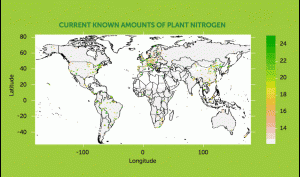As researchers and scientists tackle the emerging reality of climate change, a key question is on their minds: Just how much Earth-warming carbon dioxide can shrubs, trees, and other plants continue to process?
Carbon dioxide is the main culprit in climate change and plants absorb it, along with water and sunlight, to perform photosynthesis and grow. Historically, there have been more than enough plants to keep the Earth’s free-floating carbon dioxide in check and the climate cooler. But now, the effects of deforestation and extra carbon dioxide from fossil fuel usage are degrading the ability of plants to do their job.
A major obstacle in gauging the ongoing capacity of plants to process carbon dioxide is that scientists have no accurate way to estimate the current total coverage of plants across the planet or project what coverage will be like in the future.

School of Public Health recent Biostatistics graduate Abhirup Datta, PhD ’16, is helping close this mammoth information gap. As a student, Datta was a member of a University of Minnesota team developing a new statistical model designed to use global plant data to accurately estimate the amount of greenery across the Earth and its effects on the environment. The model will be used to produce highly detailed maps projecting various climate change scenarios associated with plant coverage.
“This work is directly related to the health of the planet and human health,” says Datta, who specializes in geostatistics, which involves performing scientific statistical work using large data sets from across vast geographic regions. “Plants absorb around 25 percent of the carbon dioxide in the atmosphere and we’re not certain with the changing climate that they’ll continue to do so in the future, which would have an impact on everyone.”
The project has already caught the attention of the international climate change community. The U.S. Department of Energy’s Oakridge National Laboratory is funding the project with plans to include the model in the next generation of highly accurate climate change models used by scientists around the world.
The current models, developed in the 1980s, make broad predictions for changes in global temperature and sea rise. The problem is that these models don’t factor in how plants shape climate change or how climate change will influence the health of plants.
The new biodiversity model that Datta and others are working on makes use of a database of 100,000 plants created in part by researchers at the University. Known as the TRY database, it contains 5.6 million records describing various plant characteristics.

As large as the database is, many regions in areas like Canada, Russia, and large swaths of Africa have never even been surveyed, creating holes in the data that severely limit the new model’s accuracy.
Filling in those holes requires someone with the expertise to cleverly use acquired data from one region and extrapolate it to describe what’s happening in another — someone like Datta.
Datta got his chance to work on the project through his adviser, former SPH Professor Sudipto Banerjee, who’s now at UCLA.
“Sudipto gave me some papers regarding the project and I got really interested,” says Datta. “He gave me a lot of independence in research, but was always there to guide me in all my projects — including this one. He has been a great mentor for me.”
A colleague on the University team, computer science researcher Arindam Banerjee, now oversees Datta’s work on the model and says he is uniquely suited for it.
“I’ve been learning about the ecology side of this project for five years and Abhirup picked it up in only a few months,” says Banerjee. “You’ll often find someone who is good at the math part of a project but they can’t understand the complexities of a problem and be able to communicate and work with other scientists. But Abhirup got right down to business working with the other researchers.”
Completing the project will take place over the next few years. Datta, who graduated in May 2016 and was supported by a graduate school interdisciplinary scholarship, is joining the faculty of Johns Hopkins University and hopes to continue collaborating with the University of Minnesota on creating the global plant maps to help stem the rising risks of carbon dioxide and climate change.
